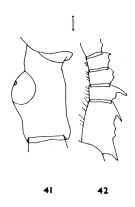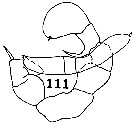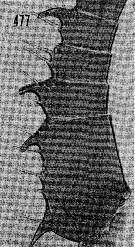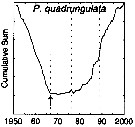|
|
 |
|
Calanoida ( Order ) |
|
|
|
Metridinidae ( Family ) |
|
|
|
Pleuromamma ( Genus ) |
|
|
| |
Pleuromamma quadrungulata (F. Dahl, 1893) (F,M) | |
| | | | | | | Syn.: | Pleuromma quadrungulatum F. Dahl, 1893 (p.105) | | | | Ref.: | | | Giesbrecht & Schmeil, 1898 (p.109); Wolfenden, 1911 (p.289, fig.F); Esterly, 1911 (p.329, figs.F,M); Steuer, 1932 a (p.26, 29, 49, 63, 76, figs.F,M); Sewell, 1932 (p.266, figs.F); Steuer, 1933 (p.14, figs.F, M); Sewell, 1947 (p.168, Rem.: forme typica); Davis, 1949 (p.52, figs.F,M, Rem.); Brodsky, 1950 (1967) (p.310, figs.F,M); Marques, 1953 (p.115, fig.M); Vervoort, 1957 (p.124, Rem.); Grice, 1962 (p.218, figs.F, Rem.); Vervoort, 1965, Rem.); Owre & Foyo, 1967 (p.74, figs.F,M); Bradford, 1970 a (p.357, figs.F); Dawson & Knatz, 1980 (p.5, figs.F); Björnberg & al., 1981 (p.642, figs.F,M); Gardner & Szabo, 1982 (p.338, figs.F,M); Ferrari, 1984 a (p.168, 170); Chihara & Murano, 1997 (p.839, tab.7); Bradford-Grieve & al., 1999 (p.884, 949, figs.F,M); Bradford-Grieve,1999 b (p.123, figs.F,M, Rem., figs.179, 192) |  isued from : J.M. Bradford-Grieve in The Marine Fauna of New Zealand: Pelagic Calanoid Copepoda. National Institute of Water and Atmospheric Research (NIWA). NIWA Biodiversity Memoir, 111, 1999. [p.123, Fig.84]. Female (46°46'S, 164°45'E): A, habitus (dorsal); B, genital somite (right lateral side); C, P5. Male: D, habitus (dorsal); E, P5. Female characyeristics: Genital swelling placed anteriorly on genital segment. - Pigment spot on right side. - A1 proximal segments with 4 large incurved teeth; 2 on segment 1, 1 on segment 2, and 1 on segment 4. - P5 4-segmented, distal segment with 3 apical bristles. Male characteristics: Urosome almost symmetrical. - Pigment spot on right side. - Left A1 geniculate, proximal segments with 4 tooth, segment 17 without a tooth, segment 18 rasp with small, oblique teeth. - Denticles on endoppod segment 1 of P2 on both sides. - Right P5 distal segment obviously widened; preceding segment with a large process.
|
 issued from : J.M. Bradford in N.Z. Jl Mar. Freshw. Res., 1970, 4 (4). [p.357, Figs 41-42]. Female (off Kaikoura, New Zealand): 41, genital segment (lateral left side); 42, proximal segments of A1 Scale bar represent 0.1 mm. Nota: the specimens agree with Steuer's (1932) description of forma psychrophila.
|
 Issued from : R.B.S. Sewell in Mem. Indian Mus., 1932, X (continued). [p.267, Fig.90]. Female (from off Sri Lanka): a, proximal segments of A1; b, P1; c, P2; d, exopod of P3; e, P5.
|
 issued from : R.N. Wolfenden in Die Marinen Copepoden der Deutschen Südpolar-Expedition 1901-1903, 1911. [p.289, Fig.47]. Female: proximal segments of A1.
|
 issued from : C.O. Esterly in Univ. Calif. Publs Zool., 1911, 6 (14). [Pl.30, Fig.65]. Female (from San Diego Region): 65, first four segments of right A1.
|
 issued from : C.O. Esterly in Univ. Calif. Publs Zool., 1911, 6 (14). [Pl.32, Fig.111]. Male: P5.
|
 issued from : G.D. Grice in Fish. Bull. Fish and Wildl. Ser., 1962, 61. [p.217, Pl.22, Figs.8-12]. As Pleuromamma quadrungulata f. typica. Female (from equatorial Pacific): 8-9, habitus (dorsal and lateral, respectively); 10, anal segment and caudal rami (dorsal); 11, proximal part of A1; 12, P5. Nota: This form is distinguished from forma psychrophila Steuer, by the presence of a large curved tooth on the 4th segment of A1 (in forma psychrophila this tooth is reduced in size and not curved).
|
 issued from : H.B. Owre & M. Foyo in Fauna Caribaea, 1, Crustacea, 1: Copepoda. Copepods of the Florida Current. 1967. [p.72, Fig.469]. Female: 469, habitus (dorsal).
|
 issued from : H.B. Owre & M. Foyo in Fauna Caribaea, 1, Crustacea, 1: Copepoda. Copepods of the Florida Current. 1967. [p.73, Fig.477]. Female: 477, A1 §proximal segments).
|
 Issued from : M.C. Kos in Field guide for plankton. Zool Institute USSR Acad., Vol. I, 1972. As Pleuromamma quadrungulata f. typica. After Steuer, 1932.
Male: 1, abdomen (dorsal); 2, P5.
| | | | | Compl. Ref.: | | | Esterly, 1916 (p.171, 179, nutrition); Wilson, 1942 a (p.202); Sewell, 1948 (p.328, 521, 530, 531, 532, 548, 557, 567); C.B. Wilson, 1950 (p.290); Fleminger, 1967 a (tabl.1); Morris, 1970 (p.2301); Gueredrat, 1971 (p.300, fig.2, 10, Table 1, 2); Lee & al., 1971 (p.1150); Timonin, 1971 (p.281, trophic group); Bainbridge, 1972 (p.61, Appendix Table III: occurrence); Björnberg, 1973 (p.338, 388); Tranter, 1977 (p.596, 602); Timonin & Voronina, 1977 (p.291); Vives, 1982 (p.293); De Decker, 1984 (p.316); Guangshan & Honglin, 1984 (p.118, tab.); Sazhina, 1985 a (p.491, tab.2); Brenning, 1985 a (p.28, Table 2); 1986 (p.9, Rem.); Saraswathy, 1986 (p.192); Madhupratap & Haridas, 1986 (p.105, tab.1); Rudyakov, 1986 (tab.1); Hernandez-Trujillo, 1989 a (tab.1); Cervantes-Duarte & Hernandez-Trujillo, 1989 (tab.3); Heinrich, 1990 (p.18); Hattori, 1991 (tab.1, Appendix); Baessa De Aguiar, 1991 (1993) (p.107); Landry & al., 1994 (p.55, abundance, grazing); Webber & Roff, 1995 (tab.1); Errhif & al., 1997 (p.422); Suarez-Morales & Gasca, 1998 a (p.110); Hernandez-Trujillo, 1999 (p.284, tab.1); Razouls & al., 2000 (p.343, Appendix); Haury & al., 2000 (p.69, Table 1); Rebstock, 2001 (tab.2); 2002 (p.71, Table 3, 5, 6, Fig.2, climatic variability); Lavaniegos & Jiménez-Pérez, 2006 (tab.2, 3, 4, Rem.); Neumann-Leitao & al., 2008 (p.799: Tab.II, fig.6); Morales-Ramirez & Suarez-Morales, 2008 (p.520); Fernandes, 2008 (p.465, Tabl.2); Gaard & al., 2008 (p.59, Table 1, N Mid-Atlantic Ridge); Galbraith, 2009 (pers. comm.); Park & Ferrari, 2009 (p.143, Table 5, Appendix 1, biogeography); C.E. Morales & al., 2010 (p.158, Table 1); Schnack-Schiel & al., 2010 (p.2064, Table 2: E Atlantic subtropical/tropical); Hidalgo & al., 2010 (p.2089, Table 2); Medellin-Mora & Navas S., 2010 (p.265, Tab. 2); Hidalgo & al., 2012 (p.134, Table 2); Teuber & al., 2013 (p.1, Table 1, 2, abundance vs oxygen minimum zone, respiration rates); in CalCOFI regional list (MDO, Nov. 2013; M. Ohman, comm. pers.); Bode M. & al., 2013 (p.1, respiration rate & ETS activity); Fierro Gonzalvez, 2014 (p.1, Tab. 3, 5, occurrence, abundance); Palomares-Garcia & al., 2018 (p.178, Table 1: occurrence) | | | | NZ: | 18 | | |
|
Distribution map of Pleuromamma quadrungulata by geographical zones
|
| | | | | | | | | | | |  issued from : M. Saraswathy in Mahasagar-Bull. Nat. Inst. Oceanogr., 1986, 19 (3). [p.191, Fig.2D]. issued from : M. Saraswathy in Mahasagar-Bull. Nat. Inst. Oceanogr., 1986, 19 (3). [p.191, Fig.2D].
Distribution of P. quadrungulata in the Indian Ocean (in the upper water column of 200 m).
Triangle: South West Moonsoon season: April 16 to October 15 (white triangle = negative stations; black = animals collected). Circle: North East Moonsoon season: October 16 to April 15 (white circle = negative stations; black = numbers of ianimals collected).
Nota: Mainly distributed between 10°N and 10°S. Vey rare species found during the SW moonsoon season. |
 issued from : G.A. Rebstock in Global change Biology, 2002, 8. [p.77, Fig.2 c]. issued from : G.A. Rebstock in Global change Biology, 2002, 8. [p.77, Fig.2 c].
Climatic regime shifts and decadal-scale variability in calanoid copepod populations off southern California (31°-35°N, 117°-122°W.
Cumulative sums of nonseasonal anomalies from the long-term means of copepod abundance from years 1950 to 2000.
A negative slope indicates a period of below-average anomalies; a positive slope indicates a period of above-average anomalies. Abrupt changes in slope indicate step changes. Step changes are marked with arrow (downward -pointing for decreases).
The October 1966 cruise (prior to the increase in sampling depth), March 1976 cruise (prior to the 1976-77 climatic regime shift), and October 1988 cruise (prior to the hypothesized 1989 climatic regime shift) are marked with vertical lines. |
 Issued from : M. Bode, A. Schukat, W. Hagen & H. Auel in J. Exp. Mar. Biol. Ecol., 2013, 444. [p.3, Table 1]. Issued from : M. Bode, A. Schukat, W. Hagen & H. Auel in J. Exp. Mar. Biol. Ecol., 2013, 444. [p.3, Table 1].
Dry mass, individual respiration rate and ETS activity from the northern Benguela Current upwelling system along transects at 23°S and 26°40'S, off Walvisbay and Lüderitz (Namibia).
Relationship between individual ETS activities and individual respiration rates; mean ETS activities with standard deviations are plotted again mean respiration rates (Cf. in Calanoides natalis Fig.3). The letter besides each point identifies the associated species in Table 1 (l, for this species) in the same authors. |
| | | | Loc: | | | sub-Antarct. (Indian, SE Pacif.), South Africa (S), Namibia, Angola, SE Atlant., G. of Guinea, off Lagos, off Mauritania, Brazil, off Amazon, Barbados Is., Caribbean Colmbia, Caribbean Sea, Jamaica, Florida, Bermuda, Arabian Sea, Maldive Is., Indian, Bay of Bengal, S Indian (subtropical convergence), China Seas (East China Sea), Japan (off Sanriku), W Australia, Philippines, New Zealand (Kaikoura), British Columbia, California, Santa Monica Basin, San Diego, W Baja California, La Paz (S Baja California), W Costa Rica, Pacif. (W equatorial), New Caledonia, New Zealand (South Island E), Tasman Sea, S Tasmania, off N Hawaii, Pacif. (equatorial, sub-tropical), Pacif. (SE tropical), Chile (N & S, off Santiago, Cocepcion) | | | | N: | 74 | | | | Lg.: | | | (22) F: 5-3,32; M: 4,45-3,08; (44) F: 3,62-3; (75) M: 3,75; (143) F: 3,48; M: 3,55; (313) F: 4,55; (864) F: 2,43; (909) F:3,9-4,6; M: 3,9-4,4; {F: 2,43-5,00; M: 3,08-4,45}
The mean female size is 3.787 mm (n = 9; SD = 0.8310), and the mean male size is 3.855 mm (n = 6; SD = 0.5211). The size ratio (male : female) is 0.967 (n = 3; SD = 0.0580). | | | | Rem.: | Meso-bathypelagic. Considerd as vertical migrator.
Sampling depth (sub-Antarct.) : 0-1000 m.
Sazhina (1985 a) reports a length of 2.43 mm for two females in the equatorial Indian Ocean.
Steuer (1931, p.7) created two forms: typica & psychrophila.
Pleuromamma quadrungulata psychrophila Steuer,1931 (F,M)
Ref.: Steuer, 1931 (p.7); 1932 a (p.29, fig.F); 1933 (p.16, fig.F); Marques, 1953 (p.115, fig.M); Vervoort, 1965 (p.108, Rem.); Bradford-Grieve,1999 b (p.124: Rem. Lg.F = 4,2-4,5 mm)
Loc.: G. of Guinea, Angola, South Africa, Indian, New Zealand (North Island SW)
Pleuromamma quadrungulata typica Steuer,1931
Ref.: Steuer, 1931 (p.7); 1932 a (p.26, 29, 49, 63, 76); 1933 (p.16); Sewell, 1947 (p.169, Rem.); Vervoort, 1965 (p.108, Rem.); Bradford-Grieve,1999 b (p.124: Rem. Lg.F = 4,45 mm)
Rem.: Cf. Pleuromamma quadrungulata quadrungulata.
Pleuromamma quadrungulata quadrungulata (F. Dahl,1893) (F,M)
Syn.: P. quadrungulata typica Steuer, 1931 (p.7); 1932 a (p.29); 1933 (p.16, figs.F,M); Vervoort, 1957 (p.124); Grice, 1961 (1962) (p.218, figs.F)
Ref.: Vervoort, 1965 (p.108, Rem.); Grice & Hulsemann, 1967 (p.17); in CalCOFI regional list (MDO, Nov. 2013; M. Ohman, comm. pers.);
Loc.: Atlant., Indian, Pacif.
Lg.: (16) F: 3,9-3,7; M: 3,3-3,15; (101) F: 3,77; 3,51
Cf. Pleuromamma quadrungulata.
Timonin (1971, p.282) considers the trophic interrelations in the equatorial and tropical Indian Ocean, and divides the plankters into 6 trophic groups from the litterature and the results of studies of mouth-parts structure and intestine content. This species is omnivorous.
: R. Stephen, 2007 : Data sheets of NIO, Kochi, India (on line).
| | | Last update : 28/11/2020 | |
| | | | Could you please clarify where in region 9 of your map Pleuromamma quadrangulata is found?
Thank you very much for your help,
Claudia Castellani
| |
|
|
|
 Any use of this site for a publication will be mentioned with the following reference : Any use of this site for a publication will be mentioned with the following reference :
Razouls C., Desreumaux N., Kouwenberg J. and de Bovée F., 2005-2025. - Biodiversity of Marine Planktonic Copepods (morphology, geographical distribution and biological data). Sorbonne University, CNRS. Available at http://copepodes.obs-banyuls.fr/en [Accessed November 03, 2025] © copyright 2005-2025 Sorbonne University, CNRS
|
|
 |
 |














